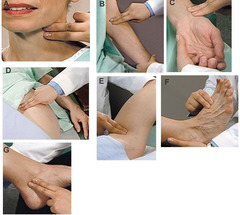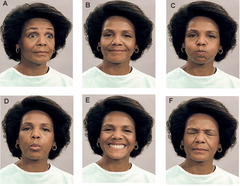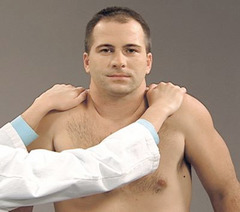HESI Case Study:Neurological Assessment – Flashcards
Unlock all answers in this set
Unlock answersquestion
(Prirority Data Collection) The nurse begins the admission assessment with the collection of priority assessment data that is immediately entered into her personal digital assistant (PDA.) Which assessment should the nurse complete first after the client's arrival on the unit?
answer
Level of consciousness. (In planning care, a top priority is client safety. Assessment of the client's level of consciousness is essential to determine the care needed to ensure client safety.)
question
Based on Ms. Davidson's recent history of loss of consciousness and falling, what additional assessment takes priority?

answer
Blood pressure and pulse. (Both hypertension and bradycardia may cause loss of consciousness, so these vital signs should be assessed immediately.)
question
The nurse measures Ms. Davidson's vital signs and assesses her level of consciousness, then proceeds to interview the patient. (Client Interview) To determine if the client experienced vertigo before she lost conciousness, what question should the nurse ask Ms. Davidson? Before you passed out, did you....
answer
Experience a spinning sensation? (Vertigo is defined as a spinning sensation.)
question
During the client interview, the nurse observes Ms. Davidson's speech patterns. Ms. Davidson seems to have difficulty choosing and forming some of her words. What action should the nurse take?
answer
Affirm the client's difficulty and question her about when this first started. (This action demonstrates caring and also enables the nurse to obtain a more complete history related to the onset of the client's symptoms.)
question
(Recording and Reporting Assessment Data) Before continuing the interview and assessment, the nurse enters the following initial data collected into her personal digital assistant (PDA): Ms. Davidson demonstrates difficulty speaking and she previously reported feeling weak, passing out, and falling at home. Her vital signs are currently T 97F, BP 140/88, P 92 and R 18. What terminology should accurately be included in the nurse's documentation?
answer
Syncope Syncope is sudden loss of strength or temporary loss of consciousness, which the client described as "passing out."
question
In documenting the client's difficulty speaking, the nurse recalls that Ms. Davidson had difficulty forming some of her words and phrases. Before describing this finding on the assessment form, what additional data should the nurse consider?
answer
The client's ability to comprehend what she is being asked. (Aphasia should be assessed to determine if the client has lost the ability to comprehend information (receptive aphasia) or the ability to express onself (expressive aphasia) most commonly, the client experiences both, referred to as global aphasia.)
question
The nurse determines that the client is able to comprehend information but has difficulty expressing herself at times. The nurse documents that the client is experiencing expressive aphasia. (Mental Status Exam) While continuing the client interview, the nurse assesses the client's mental status. As the interview continues, Ms. Davidson occasionally struggles to choose and form words, but seems comfortable and relaxed. The nurse provides a quiet, calm environment, allowing the client ample time to respond to the interview questions. Ms. Davidson asks the nurse what her room number is, stating she needs to let her daughter know where she is. Which assessment by the nurse accurately reflects the client's statement?
answer
Oriented to situation. (The client's statement that she needs to notify her daughter that she is in the hospital indicates she is oriented to her situation. Lack of knowledge of her room number does not reflect disorientation or memory loss.)
question
To assess Ms. Davidson's recent memory more completely, what action should the nurse take?
answer
Question her about how she arrived at the hospital today. (This action provides information related to the client's recent memory. The nurse should ask questions with verifiable answers to ensure the client does not make up responses.)
question
Ms. Davidson's memory is vague about the events after she passed out, but she states that she thinks that her neighbor called an ambulance to bring her to the hospital. Which interview data provides the nurse with information related to the client's judgment?
answer
The client indicated the need to notify her daughter that she is in the hospital. (Indication of good judgement.)
question
(Cranial Nerve Assessment) After completing the interview and mental status exam, the nurse tests Ms. Davidson's cranial nerves. In checking Ms. Davidson's pupillary response to light, the nurse first measures the size of the pupils. Each pupil is approximately 4mm. What action should the nurse take in response to this finding?
answer
Compare the shape of the client's pupils bilaterally. (Before checking the pupillary response to light, the nurse should first observe the size and shape of the pupils, observing for symmetry. The normal pupil size is 3 to 5mm, so the nurse should next observe and compare the shape of the pupils.)
question
After noting the size and shape of the client's pupils, the nurse tests the pupillary response to light. After the nurse asks the client to close both eyes what is the next action the nurse should take?
answer
Hold a penlight to the side of one eye. (The nurse begins by asking the client to close both eyes. This allows the pupils to dilate. The nurse next holds the penlight to the side of the eye, so it is ready as soon as the client opens her eyes.)
question
To continue the cranial nerve assessment, the nurse asks Ms. Davidson to first smile, then frown, and then show her teeth. While the client performs these tasks, what should the nurse do?

answer
Observe for symmetric facial movement. (The nurse observes for symmetric movement when the client smiles, frowns, or shows her teeth. This assessment provides data related to the function of the facial nerve, cranial nerve VII.)
question
The nurse tests cranial nerve XI by asking the client to shrug her shoulders. What action should the nurse perform?

answer
Apply resistance to the client's shoulders. (The nurse should test the client's ability to shrug her shoulders against resistance with equal strength bilaterally.)
question
(Motor Function) The nurse continues the neurological assessment by assessing motor function. Since Ms. Davidson is lying in bed, which action should the nurse take to observe small muscle movement and coordination?
answer
Ask the client to touch her thumb to each finger, the nurse observes for smooth, coordinated movement of the small muscles.
question
The nurse observes that Ms. Davidson lacks coordination when touching her thumb to the fingers on her left side and decides to further assess her upper extremity muscle strength. To assess upper extremity muscle strength, the nurse stands facing the client and holds out both hands toward the client. The nurse asks the client to grip 2 of the nurse's fingers with 1 hand and 2 fingers with the other. What instructions should the nurse provide next?
answer
Squeeze my fingers with both hands at the same time. (When performing a hand grip test, the nurse asks the client to squeeze the nurse's fingers with both hands simultaneously, so that the nurse can compare muscle strength bilaterally.)
question
Ms. Davidson's left upper extremity seems to be weaker than her right upper extremity. What additional assessment should the nurse perform to validate the finding of unilateral upper extremity weakness?
answer
Perform a palmar drift test. (A palmar drift test is used to assess upper extremity weakness. The client is asked to hold up both arms with the palms up and eyes closed for 10 to 20 seconds. The weak arm will "drift" downward.)
question
The test validates the initial findings of left upper extremity weakness. (Sensory Function) After validating the finding of left-sided upper extremity weakness, the nurse next assesses Ms. Davidson's sensory function. The nurse uses a tuning fork to evaluate what sensory function?
answer
Vibration. (The client's ability to sense vibration is assessed by placing a vibrating tuning fork on a bony surface.)
question
Next, the nurse asks Ms. Davidson to close her eyes. The nurse places the tuning fork in the palm of Ms. Davidson's left hand and asks her to identify what she is holding. Ms. Davidson is unable to identify the tuning fork. What action should the nurse take in response to this finding?
answer
Place a comb in the client's left hand and ask her to identify the object. (Stereognosis, the ability to recognize objects by touch, should be assessed by placing a familiar object in the client's hand. A tuning fork is not a familiar object to many people, so the nurse should replace the fork with a more familiar object, such as a comb.)
question
Ms. Davidson is able to identify a comb when it is placed in her right hand, but is unable to identify the comb when it is placed in her left hand. (Reflexes) The nurse continues the neurological assessment by evaluating Ms. Davidson's deep tendon reflexes (DTRs.) The nurse begins by testing the client's biceps reflex. With the client's forearm resting on the nurse's forearm and the nurse's thumb over the biceps tendon, what action should the nurse take next to test the client's biceps reflex?
answer
Strike the thumb with the reflex hammer. (With the client's forearm slightly flexed and relaxed, the nurse should strike the thumb with the pointed end of the reflex hammer to elicit a response.)
question
The nurse observes contraction of the biceps muscle and flexion of the forearm in response to the attempt to elicit the biceps reflex. What action should the nurse take in response to this finding?
answer
Explain to the client that the reflex response was normal. (The client's response is normal and should be documented as a 2+ response.)
question
(A change in condition: level of consciousness.) Shortly after completing the admission assessment, the nurse returns to the client's room and notes a change in her condition. Ms. Davidson is slurring all her words. Further assessment reveals that Ms. Davidson is no longer able to move her left arm and leg, and within a few minutes no longer responds to the nurse's questions. The nurse quickly assesses the client's level of consciousness by checking for a response to varying stimuli. What stimuli should the nurse use first to attempt to elicit a response from the patient?
answer
Call the client's name. (The nurse should begin with the least amount of stimulus and progress to the greatest amount of stimulus, observing the amount of stimulus needed to evoke a response by the patient.)
question
To objectively assess the client's level of consciousness, the nurse uses the Glasgow Coma Scale (GCS.) What data should the nurse obtain to complete the GCS rating? (Select all that apply.)

answer
Verbal response, Eye opening response, Motor response.
question
(Related Assessment: End of Life Wishes) Ms. Davidson's daughter Sylvia has arrived and the nurse explains that her mother's condition has worsened. Sylvia cries, and tells the nurse that her mother had often told her that she had lived a full, long life, and did not want any extraordinary measures in the event of a serious illness. The nurse assesses Ms. Davidson's end of life wishes. In assessing the client's end of life wishes, the nurse remembers that Ms. Davidson's husband is deceased. it is most important for the nurse to communicate with which person? The client's....
answer
Designated power of attorney for health care. (This person has been designated by the client to make health care decisions if the client is unable to do so.)
question
The nurse learns that Ms. Davidson designated her daughter Sylvia as her power of attorney. Sylvia tells the nurse that her mother was very clear in her wishes and does not wish to have external feeding, ventilation, or resuscitation implemented under any circumstances. To confirm the verbal information regarding Ms. Davidson's end of life wishes, the nurse plans to review the client's living will. What additional information related to end of life wishes is most important for the nurse to assess?
answer
Organ donor status. (It's essential for the nurse to assess the client's wishes regarding organ donation so that any necessary arrangements to preserve organs can be made prior to the client's death.)
question
The nurse may facilitate time and space for which action(s) commonly associated with spiritual end of life care related to Ms. Davidson's Catholic beliefs. (Select all that apply.)
answer
Last rites or anointing of the sick, prayer of the rosary.
question
Case Outcome
answer
Ms. Davidson's neurological function continues to worsen throughout the day. Resuscitative measures are not taken, in accordance with her wishes. Her daughter Sylvia is at her bedside when she dies early the next morning.



